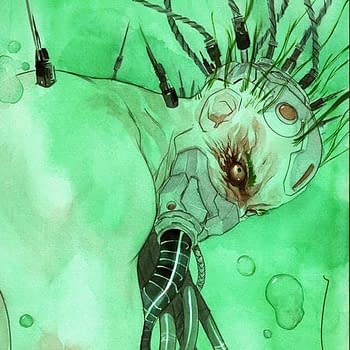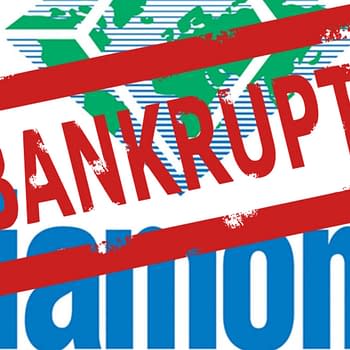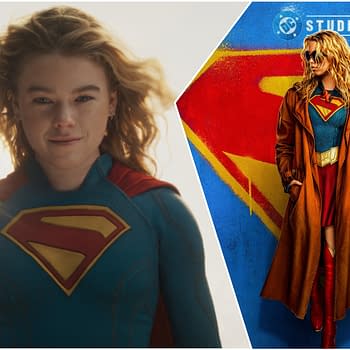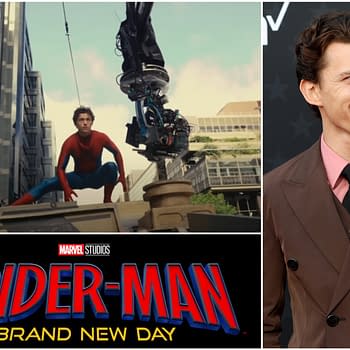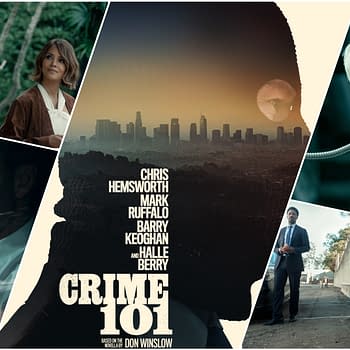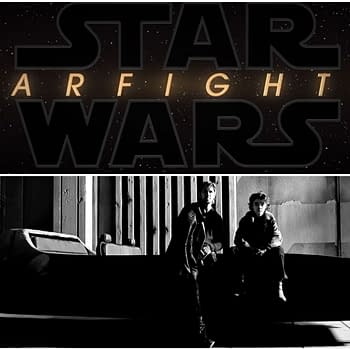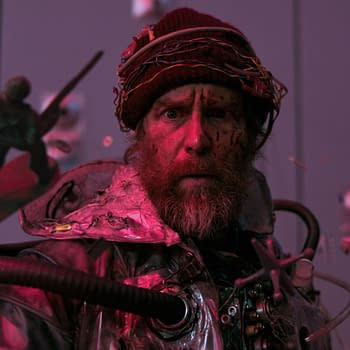Posted in: Movies | Tagged: apatosaur, arlo, disney, entertainment, finding nemo, giant robot, incredibles, peter sohn, pixar, spot, t rex, the good dinosaur, tyrannosaurus rex
A Good Look At Pixar's The Good Dinosaur, With Peter Sohn

Much will be made of the ultra realism of the computer graphics in The Good Dinosaur, as they achieve new levels of detail, representation and believability, especially when it comes to water, foliage, landscape and light. Less will be made of the contrast between that and the very stylised and cartony look of the characters. It's an approach popularised by the likes of Herge and Miyazaki, talking with director Peter Sohn later he would mention those influences, and describe how a Tintin character would hold a very realistic looking gun and the two things would sit together. Though they came to this approach through creating different worlds for these children to survive in, and how the more more realistic versions emphasised the danger that both Arlo and Spot face in the big, big world. But therein lies one of this film's big tricks – the ultra realism isn't quite as realistic as it appears, there's all sorts of creative decisions and stylistic decisions made – and equally the cartoony characters are developed with a full understanding of mass, of weight, of a place in space, and everything is joined together by light… and a fully realised world is created that reflects the emotional – and motional – weight of the story.
And yes, the light. From the obvious fireflies that shine over the fields at night, disturbed by Arlo's tail, to the moonlight reflecting off the water and scattering across the rocks, to reflecting and refracting through each rainsdrop, it's a very beautiful world too, held together by an understanding of very nature of what film actually is on a very physical level. Light.
It is a world where the meteor missed. And dinosaurs – apatosaurs at least, evolved into farmers, using their own bodies as agricultural machines, which brings to mind a kind of Animal Flintstones Farm. And Arlo is a child of that family, of Momma and Poppa, with Libby and Buck. And, yes, because this is a Pixar movie, there is parental loss, and a separation between one member of a family and the rest of it. And Arlo, who knew his surroundings so well, looked over by the three ponts of the claw toothed mountains finds himself swept away by the river, far far away. And trying to find his way home.
That's how we'll meet the many other evolved dinosaur species in this world. The styracosaurus who has evolved in symbiosis with certain mammals who use bones and horns for protection, but also look after their host. The velociraptors with hair and feathers that style them like Barcelona football players. The vulture-like pteradons that bring to mind the street chorus from Dumbo – very intentional note. And the family of T Rexes, Butch, Ramsey and Nash. The look of the characters have changed a little since earlier previews, Arlo's face is squatter and his eyes are bigger and his body is smaller, it all plays to show the character as younger than previously portrayed. He is, after all, a boy.
And then there is Spot. The human child with his own familial loss. He doesn't speak, he doesn't walk, he runs around on all fours barking and howling. And so we see The Good Dinosaur as a story about a boy and his dog, with the paradigm flipped. And it's their relationship, as they learn to trust each other and become lifelong friends that is the heart of the film. And in one scene on a beach, they are able to express their common experience to each other – and howl at the moon.
Talking of heart, before we saw the eye-weeping footage, we had another "short feature". An animated presentation by Pete Sohn, using his sketches to tell the story of his childhood, the son of Korean immigrants, and especially his relationship with his Korean-speaking mother, their trips to the cinema and how the films they connected most with, involved Disney visual storytelling, the caressing trunks scene between Dumbo and his mother being a key example. And in The Good Dinosaur, we have one main character who can't even speak – communication has to be achieved visually. He made a film that his mother could enjoy as much as his own child. The short film also took Peter through working in animation, from The Giant Robot to Finding Nemo at Pixar, first creating art and then being recruited as a result to work in the story side of the company, and how he would put his heart into his work, only for it to be crushed when it was rejected, but how it was always importantly to keep putting it back in, again and again. Which is also what he did with this short film, exposing his most vulnerable times and pitches that went wrong – we never did see the ice elevator scene in The Incredibles final fight scene, did we?
It was something I asked him about later, how he deal with other creatives given his own very vulnerable experiences. He talked about trying to get creatives to explain their work differently, and that if he thought something didn't work, encouraging them to keep it for a different project, "close the door but don't lock it". It seemed a much inclusive, softer, collaborative approach. Many directors I've met, including those at Disney and Pixar, give me the impression that they will steamroller over people in their pursuit of excellence, Peter strikes me at someone who will find a different route. He will get to the same destination, but find a way to take into account the obstacles along the way. It will take longer but he will leave fewer bodies along the route. He talked about dealing with failure, how failure can scar but its how you deal with failures, sincerity in failing, yours and others is the challenge of collaboration, recognising that failure can be as sincere as success.
Which is especially apt considering the history of the project, Sohn took over the film from director Bob Peterson after it was decided that Bob couldn't get his film to work for Pixar. But Peter, who worked with Bob on he film previously, only speaks of Bob with love, understanding, and a drive to fight for Bob's ideas onto the screen in a way that maybe Bob was unable to. He described it as a voice that got stuck, but he knew what the heart of it was.
That was probably my biggest impression from the presentation, the sincerity, the love and the belief from Sohn, reflected without cynicism on the screen, and incredibly infectious. I came out not only wanting to see the finished film so much and to share it with my children, as he chared films with his mother, but also to give Peter a big, big hug.
It's out on November 25th in the US and November 27th in the UK, folks.







